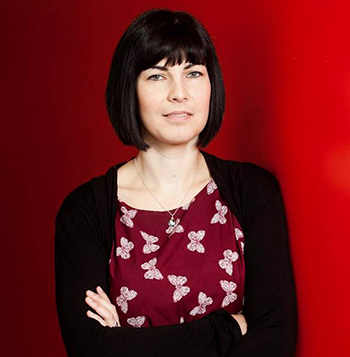
Caroline Sturdy Colls
Archaeology is like a protracted police investigation, wherein your evidence is precious because it is sparing and you’re lucky if you have a lot of witnesses.
Caroline Sturdy Colls, an associate professor of Forensic Archaeology and Genocide Investigation at Staffordshire and founder of their Centre of Archaeology, knows this with certainty, having long worked in both the fields of genocide research and homicide investigation.
“My interest in researching genocide events stems from a desire to aid in the search and recovery of missing persons,” Sturdy Colls said. “I believe loved ones have a right to know what happened in cases of genocide and that investigating these crimes, even a long time after the events, can play a vital role in education and genocide prevention.”
Sturdy Colls – a research pioneer who uses archaeological and forensic techniques in investigations of genocide to identify camps, mass graves, killing sites and other sites connected to atrocities across Europe – developed the sub-discipline of Holocaust archaeology throughout her tenure working at sites all across Europe, in Poland, Germany, Serbia, The Netherlands, Ukraine, Cyprus, Norway, the Czech Republic, Bosnia-Herzegovina and Croatia.
“It attempts to utilize scientific and historical approaches in a way that also respects the religious and commemorative significance of Holocaust sites,” Sturdy Colls said. “Hence, my research focuses both on the application of innovative techniques but also on ethical approaches in the cases involving missing persons.”
Sturdy Colls will give a talk on just that at USC Shoah Foundation’s 2017 International Conference “Digital Approaches to Genocide Studies,” co-sponsored by the USC Mellon Digital Humanities Program. The two-day conference, which will be held at the University of Southern California in Los Angeles, invited scholars from across the globe to converge and discuss the relationship between digital methodologies, practices, ethics and the nature of contemporary Holocaust and Genocide Studies.
Her discussion will center on the meshing of non-invasive techniques and traditional methods of excavation archaeologists have used to locate and record Holocaust sites and material culture, allowing new perspectives on camps, ghettos, killing sites and other complex landscapes.
“My presentation will focus on the ethical issues that must be considered when investigating cases of mass violence from this period,” Sturdy Colls said. “It will show the unique, disciplinary approach I have developed has accounted for these issues whilst also leading to the successful identification of physical evidence.”
Using case studies from the Treblinka extermination and labor camps in Poland, Bergen-Belsen and the Jewish cemetery in Auschwitz, Sturdy Colls will demonstrate the kinds of contributions archaeologically derived data and visualizations can make in understanding the Holocaust and other genocides, while also examining the ethical issues faced by project teams in creating reconstructions of sensitive and sacred landscapes.
Sturdy Colls will join over a dozen scholars at the conference, whose presentations will range from an analysis of the netnography of digital autobiographical documentary to the capacities of geographic information systems for analyzing Holocaust spaces to the usefulness of augmented reality technologies in sharing the memories of the places of genocides.
In an initial call for papers, USC Shoah Foundation asked academics to investigate the ways in which digital tools and methods, new media and information technologies can help us to challenge conventional wisdom regarding the Holocaust and Genocide Studies by raising new questions, improving our understandings, deepening our analyses, widening our fields of view and pioneering new approaches.
Sturdy Colls said she looks forward to exchanging ideas with her peers at the conference and developing new research collaborations, and hopes to engage with her audience about the ethical issues surrounding her work and work in the field.
“I hope that my presentation will demonstrate that a wide range of fields can make an important contribution to Holocaust and Genocide Studies,” Sturdy Colls said. “I hope that this will raise awareness amongst the audience of the possibility to locate and characterize physical evidence from the Holocaust and other genocides, and the possibility to develop educational and other programs as a result.”
Apart from preparing for the conference, the researcher has been managing a number of projects involving cases of genocide and mass violence. As the principal investigator on four forensic archaeology research projects, Sturdy Colls has continued to undertake fieldwork across Europe, further developing her approaches. She’s also working on two combined book and television projects, on the Treblinka camps and the forced labor camps on the island of Alderney.
A television documentary about the latter work is projected to air on the Smithsonian Channel in 2018.
Throughout her years as a researcher, Sturdy Colls has used USC Shoah Foundation’s resources regularly, most recently as part of a fellowship with the United States Holocaust Memorial Museum.
“USC Shoah Foundation’s Visual History Archive [a collection of over 54,000 digitized and fully searchable video testimonies from survivors and other eyewitness of the holocaust, the Rwandan, Guatemalan and Armenian genocides and the Nanjing Massacre in China] is a unique and invaluable resource for researchers, educators, family members and the general public,” Sturdy Colls said. “I am delighted to be able to visit the archive and to participate in the conference.”